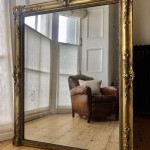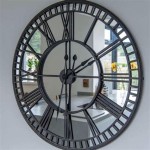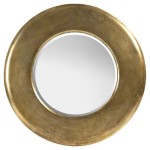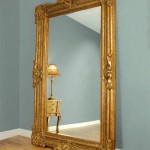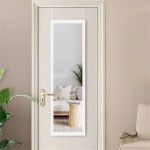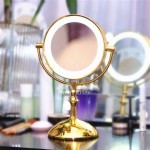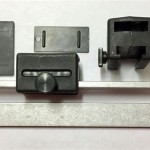How To Hang a Heavy Mirror On Tile Without Drilling
Hanging a heavy mirror on a tiled surface without drilling presents a unique challenge. Drilling into tile can lead to cracking or chipping, and specialized tools are often required. Fortunately, several effective methods allow for secure mirror installation without jeopardizing the integrity of the tile.
Before selecting a hanging method, it is critical to determine the weight of the mirror. Bathroom scales can be utilized for this purpose. Knowing the exact weight ensures the chosen adhesive or hanging system can support the load. Overestimating the weight is recommended to provide a safety margin.
The size and back of the mirror also influence the choice of hanging method. Large, heavy mirrors require robust support systems, while smaller mirrors offer more flexibility. Inspecting the mirror's back for pre-installed hanging hardware, such as D-rings or wire, is essential as it will dictate how the mirror can be attached to the chosen hanging mechanism.
One of the most popular methods for hanging heavy objects without drilling involves heavy-duty adhesive strips. These strips employ advanced adhesive technology, enabling them to hold substantial weight directly onto the tile. Different brands offer varying weight capacities, so choosing a product specifically designed for heavy mirrors is crucial. Careful adherence to the manufacturer's instructions is paramount for achieving optimal adhesion and longevity.
Before applying adhesive strips, the tile surface must be thoroughly cleaned and dried. Any residue, such as soap scum or hard water deposits, can compromise the adhesive bond. Using a suitable tile cleaner followed by a clean, dry cloth ensures a pristine surface for optimal adhesion. The manufacturer's instructions may specify a particular cleaning agent, which should be followed precisely.
Applying the adhesive strips typically involves peeling off a protective backing and firmly pressing the strip onto the back of the mirror in the designated locations. The mirror is then aligned against the tiled surface and pressed firmly for the duration specified by the manufacturer. Allowing the adhesive to cure completely before releasing the mirror is critical to achieving maximum holding strength.
Another effective no-drill method involves the use of suction cups. Suction cup hangers designed for heavy mirrors offer a strong hold on smooth, non-porous surfaces like tile. Similar to adhesive strips, ensuring the tile surface is clean and dry is crucial for maximizing suction power. Suction cups equipped with locking mechanisms provide added security and prevent accidental detachment.
When using suction cups, selecting the correct size and weight capacity for the mirror is essential. The manufacturer's specifications will generally provide guidance on the appropriate suction cup size and the maximum weight they can support. Distributing the weight evenly across multiple suction cups is recommended for larger, heavier mirrors to ensure stability and prevent undue stress on individual cups.
An alternative approach involves utilizing specialized adhesive hooks designed for use on tiles. These hooks employ a strong adhesive backing similar to heavy-duty adhesive strips, allowing them to adhere securely to the tile surface. The mirror is then hung directly onto these hooks, provided the back of the mirror is equipped with appropriate hanging hardware. As with adhesive strips, meticulously following the manufacturer's instructions regarding weight limits and application procedures is essential.
For mirrors with pre-installed wire hanging systems, heavy-duty picture hanging wire coupled with adhesive hooks can provide a secure hanging solution. The wire is attached to the hooks, which are adhered to the tile, distributing the weight of the mirror across multiple points. This method is particularly suitable for larger, heavier mirrors as it spreads the load more evenly than relying on a single point of contact.
Regardless of the chosen method, periodically inspecting the hanging system for signs of wear or weakening is recommended. Factors such as humidity and temperature fluctuations can affect the performance of adhesives and suction cups over time. Replacing worn or damaged components promptly ensures the continued safe and secure display of the mirror.
Finally, considering the location and surrounding environment is crucial when deciding how to hang a heavy mirror without drilling. Areas prone to high humidity, such as bathrooms, may require more robust solutions due to the potential impact of moisture on adhesive strength. In such environments, opting for heavy-duty adhesive strips specifically designed for humid conditions or utilizing suction cups might be more appropriate.

How To Hang Mirrors On Tile 3 Ways A Bonus The Palette Muse

How To Hang A Bathroom Mirror Without Nails S Or Drilling Velcro Brand

How To Hang Mirrors On Tile 3 Ways A Bonus The Palette Muse

How To Hang A Mirror On Tile Wall Remington Avenue

How To Mount Bathroom Accessories On Tiles Without Drilling Velcro Brand

How To Hang Mirrors On Tile 3 Ways A Bonus Hanging Mirror Heavy Round Bathroom

How To Hang A Mirror On Wall Without Nails

How To Hang Install A Bathroom Mirror By Mira Showers

How To Hang A Hanging Mirror Without Accompanying Hardware

How To Hang A Large Or Heavy Mirror

